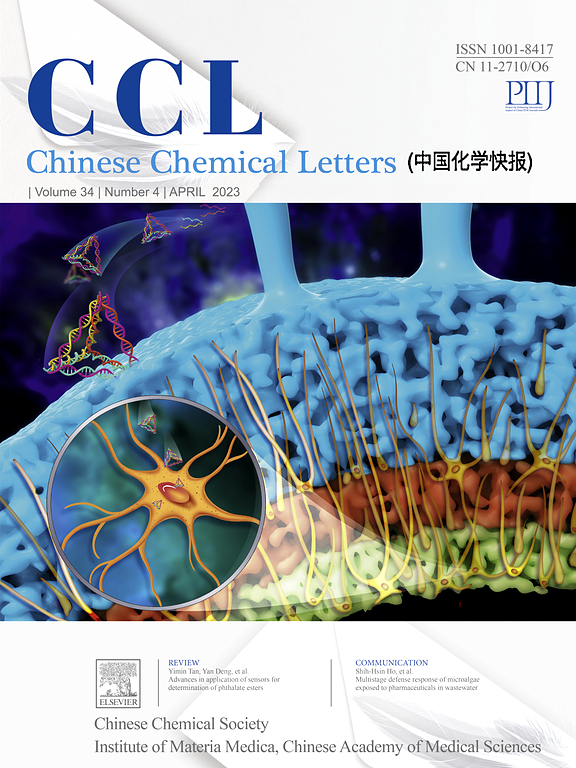聚多巴胺改性生物炭(支持聚乳酸和零价铁)影响模拟地下水中去除 1,1,1- 三氯乙烷的功能微生物群落结构
IF 9.4
1区 化学
Q1 CHEMISTRY, MULTIDISCIPLINARY
引用次数: 0
摘要
利用功能材料原位增强生物还原是一种去除地下水中氯化碳氢化合物的经济有效的技术。本文合成了一种新型聚多巴胺(PDA)改性生物炭(BC)复合材料,其中含有纳米级零价铁(nZVI)和聚乳酸(PLLA)(PB-PDA-Fe),用于提高实际场地沉积物模拟地下水中 1,1,1-三氯乙烷(1,1,1-TCA)的去除率。同时还研究了其对系统中功能微生物群落结构的影响。典型的表征结果表明,聚乳酸和 nZVI 颗粒在 BC 表面均匀分散,在涂覆 PDA 后更加光滑。该复合材料对 1,1,1-三氯乙酸的去除率(82.38%,初始浓度 100 mg/L)明显高于 Fe-PDA 和 PB-PDA 处理。由于 PLLA-BC 和 nZVI 的协同作用,复合处理中微生物群落的多样性和丰富度在培养过程中持续下降。通过 DNA 稳定同位素探针(DNA-SIP),确定了脱硫杆菌、Pedobacter、Sphaerochaeta、Shewanella 和 Clostridium 是复合材料中的富集菌属,它们在生物还原脱氯过程中发挥着重要作用。上述结果表明,这种新型复合材料可选择性地增强具有细胞外呼吸功能的微生物有效脱氯 1,1,1-TCA 的活性。这些发现有助于了解碳-铁复合材料对微生物群落的响应,并加快应用原位增强生物还原法有效修复受氯烃类污染的地下水。本文章由计算机程序翻译,如有差异,请以英文原文为准。
Polydopamine-modified biochar supported polylactic acid and zero-valent iron affects the functional microbial community structure for 1,1,1-trichloroethane removal in simulated groundwater
In-situ enhanced bioreduction by functional materials is a cost-effective technology to remove chlorinated hydrocarbons in groundwater. Herein, a novel polydopamine (PDA)-modified biochar (BC)-based composite containing nanoscale zero-valent iron (nZVI) and poly-l-lactic acid (PLLA) (PB-PDA-Fe) was synthesized to enhance the removal of 1,1,1-trichloroethane (1,1,1-TCA) in simulated groundwater with actual site sediments. Its impact on functional microbial community structure in system was also investigated. The typical characterizations revealed uniform dispersion of PLA and nZVI particles on the BC surface, being smoother after PDA coating. The composite exhibited a significantly higher performance on 1,1,1-TCA removal (82.38%, initial concentration 100 mg/L) than Fe-PDA and PB-PDA treatments. The diversity and richness of the microbial community in the composite treatment consistently decreased during incubation due to a synergistic effect between PLLA-BC and nZVI. Desulfitobaterium, Pedobacter, Sphaerochaeta, Shewanella, and Clostridium were identified as enriched genera by the composite through DNA-stable isotope probing (DNA-SIP), playing a crucial role in the bioreductive dechlorination process. All the above results demonstrate that this novel composite selectively enhances the activity of microorganisms with extracellular respiration functions to efficiently dechlorinate 1,1,1-TCA. These findings could contribute to understanding the responsive microbial community by carbon-iron composites and expedite the application of in-situ enhanced bioreduction for effective remediation of chlorinated hydrocarbon-contaminated groundwater.
求助全文
通过发布文献求助,成功后即可免费获取论文全文。
去求助
来源期刊

Chinese Chemical Letters
化学-化学综合
CiteScore
14.10
自引率
15.40%
发文量
8969
审稿时长
1.6 months
期刊介绍:
Chinese Chemical Letters (CCL) (ISSN 1001-8417) was founded in July 1990. The journal publishes preliminary accounts in the whole field of chemistry, including inorganic chemistry, organic chemistry, analytical chemistry, physical chemistry, polymer chemistry, applied chemistry, etc.Chinese Chemical Letters does not accept articles previously published or scheduled to be published. To verify originality, your article may be checked by the originality detection service CrossCheck.
 求助内容:
求助内容: 应助结果提醒方式:
应助结果提醒方式:


